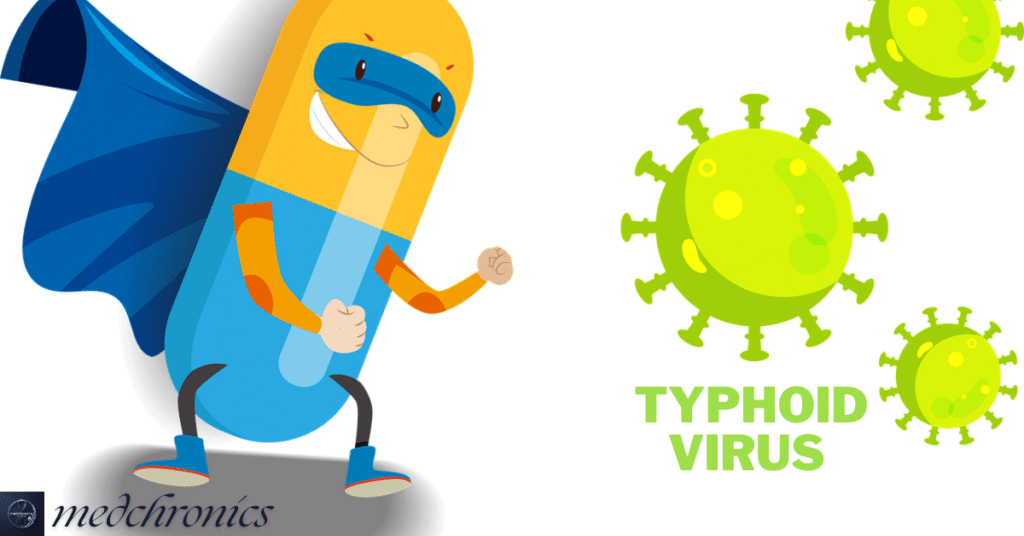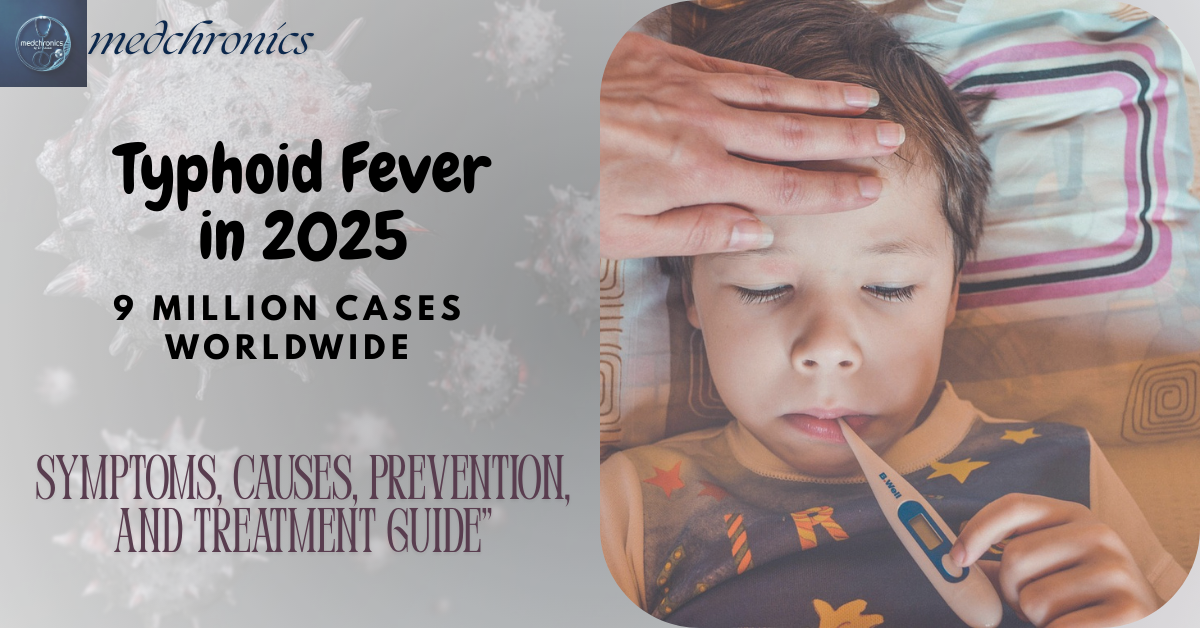An infectious disease that can be fatal, typhoid fever is brought on by the Salmonella enterica serotype Typhi (also known as Salmonella Typhi). Humans are the main victims, and it is spread by consuming food or drink infected with an infected person’s stool. Typhoid is connected to improper food handling practices, not having sufficient access to potable water, and poor sanitation because of this mode of transmission.
The infection is especially noticeable in locations with poor sanitary infrastructure and busy living circumstances, like sections of Africa, South Asia, including India, and some parts of Latin America. Since it is a systemic illness, the germs can infect several organs and travel throughout the body through the circulation.
The bacteria enter the bloodstream after entering the intestines through food or water that has been contaminated, and symptoms usually appear 6 to 30 days after consumption, with an average of 1 to 3 weeks. It may be difficult to identify symptoms at first because they develop gradually. Typhoid fever can last for several weeks or even years without prompt and efficient treatment, and it can cause catastrophic side effects such sepsis and intestinal perforation.
The main goals of typhoid preventive initiatives are to improve sanitation and hygiene, supply safe drinking water, and vaccinate high-risk populations. To decrease the disease’s worldwide burden, it is important to raise awareness of its symptoms, transmission, and preventative strategies.
Table of Contents
Symptoms
Over the course of the illness, typhoid fever symptoms usually develop through multiple phases, each with unique characteristics:
1- During the first week of the development phase
- After infection, symptoms appear six to thirty days later.
- Fatigue, malaise, headache, dry cough, fever that gradually rises to about 39–40°C (102–104°F), and occasionally constipation are early symptoms.
- The fever may fluctuate, rising more slowly than other infections.
- Muscle aches and appetite loss are possible side effects for certain persons.
- Abdominal pain may start out mild.
- Epistaxis, or nasal bleeding, can happen occasionally.
2- Acute/Febrile Phase, Second Week
- Approximately one-third of individuals may develop classic “rose spots” on their trunk, which are flat, pinkish-red patches.
- Abdominal discomfort is particularly severe in the bottom right corner, and one’s abdomen may appear enlarged.
- Constipation or diarrhea are examples of gastrointestinal symptoms that might occasionally alternate.
- Hepatosplenomegaly, or enlarged and painful liver and spleen, are further symptoms.
- There may be neuropsychiatric symptoms, such as disorientation or delirium (“nervous fever”).
- Patients frequently experience extreme weakness and fatigue.
- Consistently high temperatures are maintained, often falling below 40°C/104°F.
3- Week Three: Toxic Phase and Complications
- Symptoms get much severe if left untreated.
- Intestine bleeding or perforation are examples of severe intestine complications that might occur; these are medical emergencies that result in severe abdominal discomfort.
- Other side effects include septicemia, severe weakness, dehydration, and encephalitis (brain inflammation).
- Prolonged high fever, deteriorating stomach symptoms, and systemic sickness may continue if therapy is not received.
4- Week Four and Up (Recuperation or Relapse)
- When antibiotics are taken on time, symptoms start to get better.
- Fever and other symptoms may reappear in some patients who recover.
- The temperature, appetite, and weakness all progressively subside, though recovering completely may take several weeks.

Prevention
Targeting the fecal-oral pathway that the bacterium Salmonella Typhi utilize to propagate is the main strategy for preventing typhoid disease. The following are some of the most crucial preventative measures:
- Safe Drinking Water: Make sure to only consume bottled, boiled, or treated water. Steer clear of tap water and untreated water-based ice, particularly when visiting or residing in endemic regions.
- Maintain Good Food Hygiene: Eat only prepared food and refrain from eating vegetables and fruits that are raw unless they have been peeled or cleaned with clean water. Cuisine from questionable sources and street cuisine should be avoided.
- Hand hygiene: It’s important to regularly and thoroughly wash your hands with soap with fresh water, especially before eating or cooking and after using a public restroom.
- Sanitation Improvements: By reducing environmental contamination and restricting opportunities for bacterial spread, supply to fresh, hygienic waste management and clean water infrastructure helps improve sanitation.
- Vaccination: Those who live in high-risk areas, visit these areas, or experience an outbreak are advised to get a typhoid vaccine. Although vaccines decrease the burden of disease, they are not necessarily 100% protective; therefore, extra precautions must still be taken.
- Abstain Clear of Carriers: Even after recovering from typhoid, some people may still harbor and excrete the bacteria. When caring for sick people, keep your distance from known carriers and maintain proper hygiene.
- Public health education helps community: wide prevention efforts by increasing awareness of how typhoid spreads and how to avoid it.
In both endemic and non-endemic locations, typhoid transmission can be successfully decreased by implementing these coordinated measures: clean food and water, sanitation, personal hygiene, immunization, and education. Such strategies are especially valuable in South Asian countries like India, where typhoid is still a serious health concern.
When it Comes Occur
In many low-income nations, typhoid is common throughout the year, with increases frequently associated with rainy seasons that contaminate water supplies.
Risk Factor
Conditions and actions that enhance the possibility of Salmonella Typhi, the disease-causing bacterium, are the main warning signs for typhoid fever. Important risk factors consist of:
- Residing in or visiting endemic regions where typhoid is prevalent, particularly regions of Africa, Latin America, and South Asia (including Bangladesh, India, and Pakistan).
- Consuming tainted food or water, frequently as a result of sewage contamination and inadequate sanitation. This includes consuming fresh fruits or vegetables that have been cleaned with tainted water, drinking untreated water, or eating food that has been handled by an infected individual.
- Inadequate handwashing, hazardous waste disposal, and cramped living quarters are examples of poor sanitation and hygiene conditions.
- Often eating meals away from home, especially in places where food safety and cleanliness are in doubt.
- Contact with carriers or infected people, including those who are symptomless yet nevertheless release bacteria.
- Crowded homes or close quarters, which encourage the spread of the disease.
Exposure at work, such as when lab workers or healthcare professionals handle Salmonella Typhi.
Childhood (early age), immunosuppressive diseases (e.g., AIDS), and early or unnecessary use of antibiotics are other concerns.
Typhoid travels through the fecal-oral route, which occurs when an individual ingests germs from fecal-contaminated food or water. These risk factors focus on the significance of safe water, proper hygiene, and food safety in preventing infection.
Current Situations in India and Across the World
- Typhoid affects 9 to 17 million people yearly worldwide, with 110,000 to 160,000 deaths.
- India contributes a high portion of cases, mostly in children. Although specific yearly numbers vary, India is still a typhoid hotspot.
- Incidence has decreased in wealthier countries due to improved sanitation; still a major public health challenge in South Asia and Africa.
Treatment
Pharmacological:
- Standard antibiotics include azithromycin, ceftriaxone, and ciprofloxacin; therapy may be complicated by resistance in some regions.
- Rehydrating and controlling temperature, discomfort, and complications are examples of supportive care.
Non-pharmacological:
- Adequate nourishment, rest, and water. Avoid preparing meals while sick and practice good hand hygiene to stop the transmission of infection.
- Although typhoid is still a major worldwide health concern, especially in developing nations, the majority of patients recover completely with early detection and efficient antibiotic treatment.
When to Consult a Physician
- If you have a high fever that doesn’t go away, stomach ache, disorientation, rash, or have recently visited a place where typhoid cases are common.
- Seek medical attention if symptoms increase or do not go away, particularly after receiving typhoid treatment.
Frequently Asked Questions
1- What is typhoid fever?
Typhoid fever is a serious bacterial infection caused by Salmonella Typhi, transmitted through contaminated food and water. It primarily affects humans and is common in areas with poor sanitation
2- What are the symptoms of typhoid fever?
Symptoms usually include a high, prolonged fever, headache, abdominal pain, constipation or diarrhea, weakness, and sometimes a rash of rose-colored spots. Symptoms develop gradually 1 to 3 weeks after exposure.
3- How does typhoid spread?
Typhoid spreads through the fecal-oral route, mainly by eating or drinking contaminated food or water. Poor sanitation and hygiene are major contributors.
4- Who is most at risk of getting typhoid?
People living in or traveling to regions with inadequate sanitation, overcrowding, and contaminated water—such as parts of South Asia and Africa—are at higher risk.
5- When does typhoid fever usually occur after exposure?
Symptoms typically appear 6 to 30 days after ingesting the bacteria, most commonly within 1 to 3 weeks.
6- Can typhoid be prevented?
Yes. Prevention includes drinking safe water, eating properly cooked food, washing hands regularly, improving sanitation, and vaccination for high-risk individuals
7- How is typhoid treated?
Typhoid is treated mainly with antibiotics. Supportive care, including rest, hydration, and nutrition, is also important. Early treatment helps prevent severe complications.
